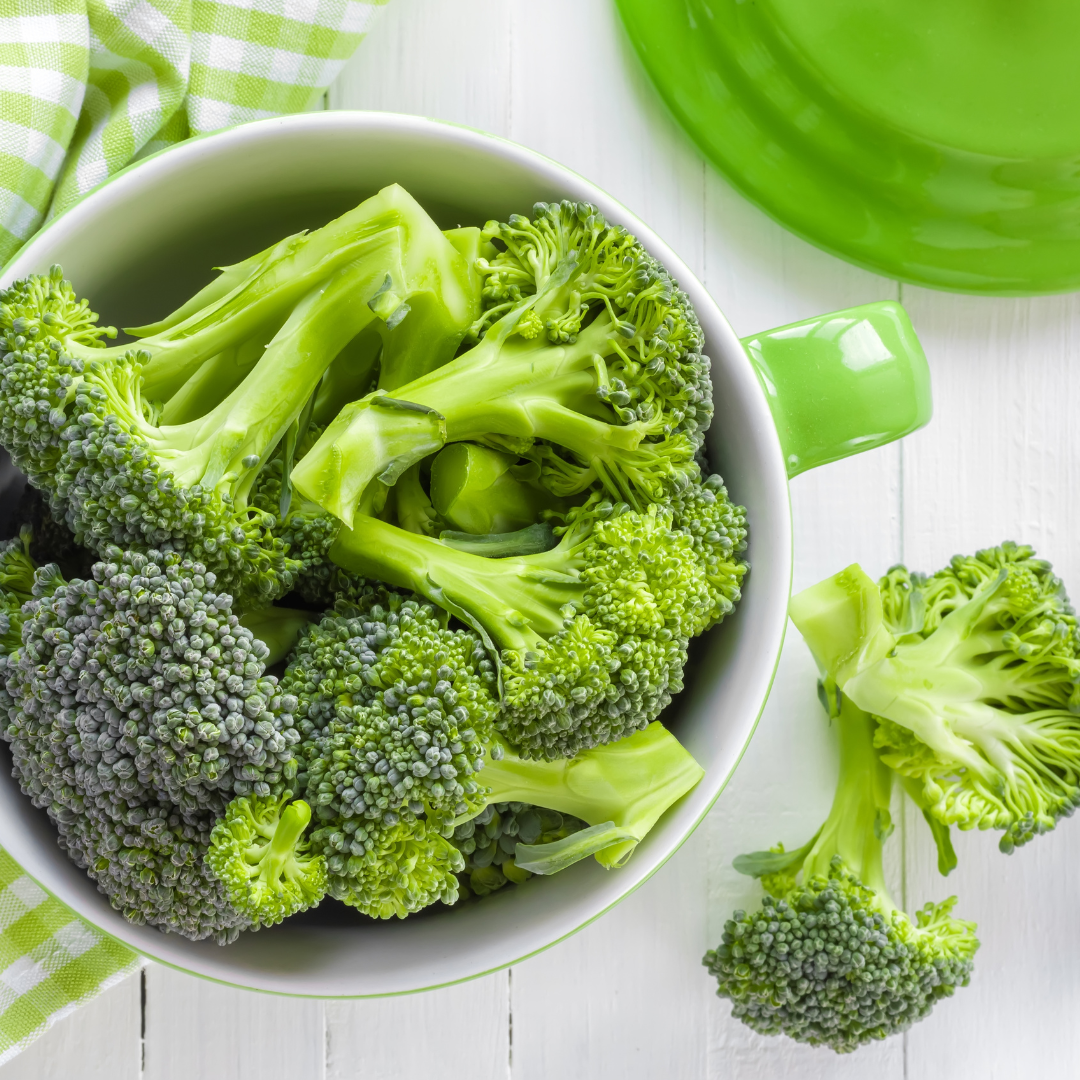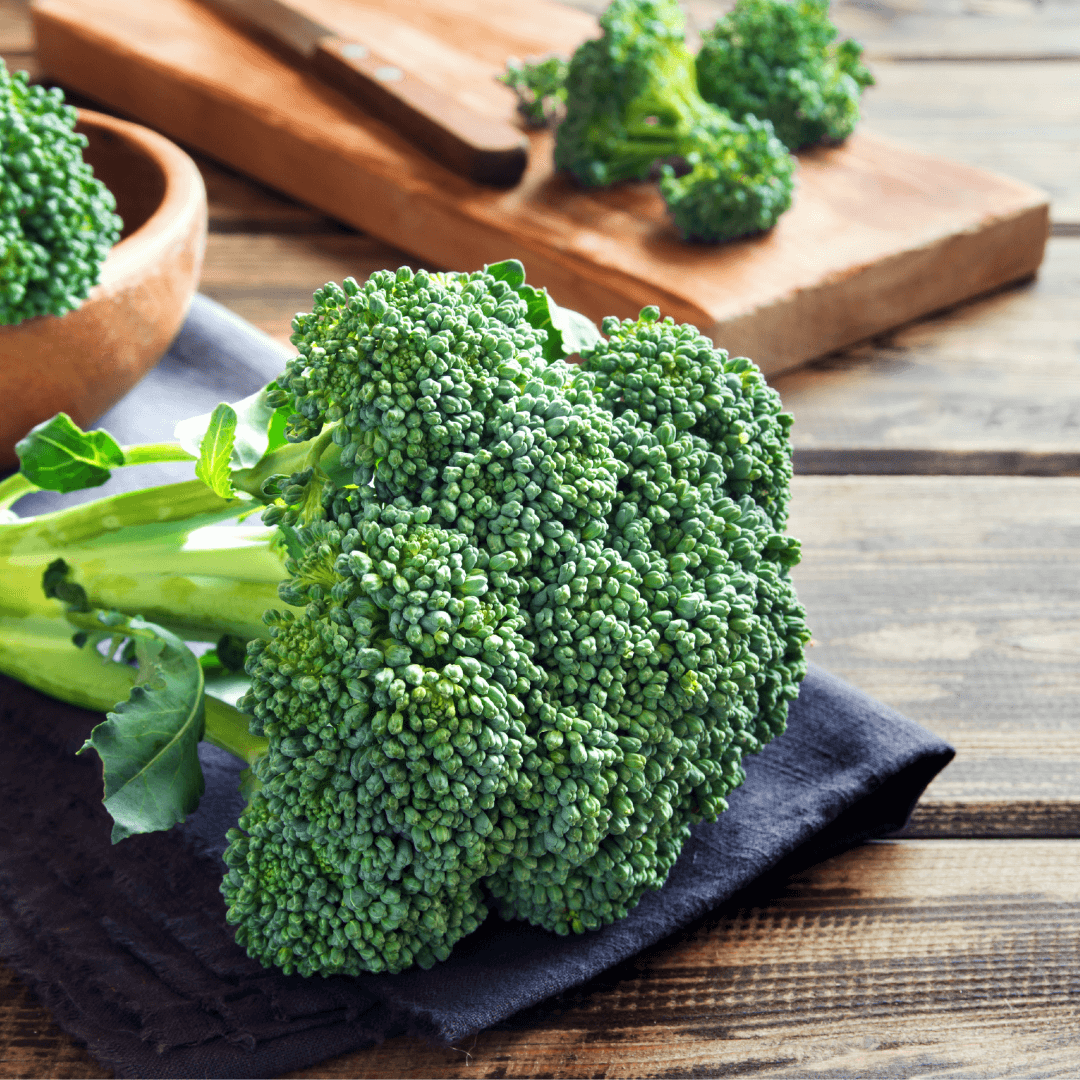Let's take a look at how to grow broccoli from seed, step by step. Broccoli is a great crop to grow and can be planted multiple times during the year.
Growing Broccoli from Seed
Growing broccoli from seed is a great way to ensure a bountiful harvest of this nutritious and delicious vegetable. Whether you're a seasoned gardener or a beginner, growing broccoli from seed is a relatively easy and rewarding experience. I will walk you through everything you need to know to successfully grow broccoli from seed.
The first step to growing broccoli from seed is to select your seeds. You can purchase broccoli seeds online in our store. Make sure to choose a variety that is suited to your climate and growing conditions. Some popular varieties of broccoli include 'Calabrese', and 'Waltham 29'.
Once you have your seeds, it's time to prepare your soil. Broccoli prefers well-draining soil that is rich in organic matter. Before planting, amend your soil with compost or aged manure. Broccoli also prefers a slightly acidic soil pH of around 6.0 to 7.0.
To start your broccoli seeds indoors, you'll need seed-starting trays or pots, seed-starting soil, and a sunny location. Fill your trays or pots with seed-starting soil, and plant your seeds according to the instructions on the packet. Broccoli seeds should be planted ¼ to ½ inch deep and spaced about 2 inches apart. Water your seeds gently, being careful not to displace them.
Broccoli seeds need to be kept moist but not waterlogged. Keep your soil consistently moist by misting it with a spray bottle or using a gentle watering can. To promote germination, cover your seed-starting trays with plastic wrap or a humidity dome until the seeds sprout.
Once your broccoli seeds have sprouted, remove the plastic wrap or humidity dome and move your seedlings to a sunny location. Broccoli seedlings need at least six hours of direct sunlight each day, so place them near a south-facing window or under grow lights. Keep the soil consistently moist and fertilize your seedlings every two weeks with a balanced, organic fertilizer.
After your seedlings have grown to a height of 3 to 4 inches, they are ready to be transplanted into your garden. Before transplanting, harden off your seedlings by gradually exposing them to outdoor conditions. This will help them adjust to the sun, wind, and temperature changes.
To transplant your broccoli seedlings, choose a location in your garden that receives full sun and has well-draining soil. Dig a hole that is slightly larger than the root ball of your seedling, and gently remove the seedling from its pot. Place the seedling in the hole, backfill with soil, and water thoroughly.
Broccoli plants need consistent moisture to produce large, healthy heads. Water your plants deeply once or twice a week, depending on the weather. Mulch around your plants to help retain moisture and suppress weeds.
As your broccoli plants grow, they may attract pests such as aphids, cabbage loopers, or flea beetles. Keep an eye out for any signs of pest damage and take action promptly. You can use organic methods such as hand-picking or insecticidal soap to control pests.
Calabrese Broccoli Seeds
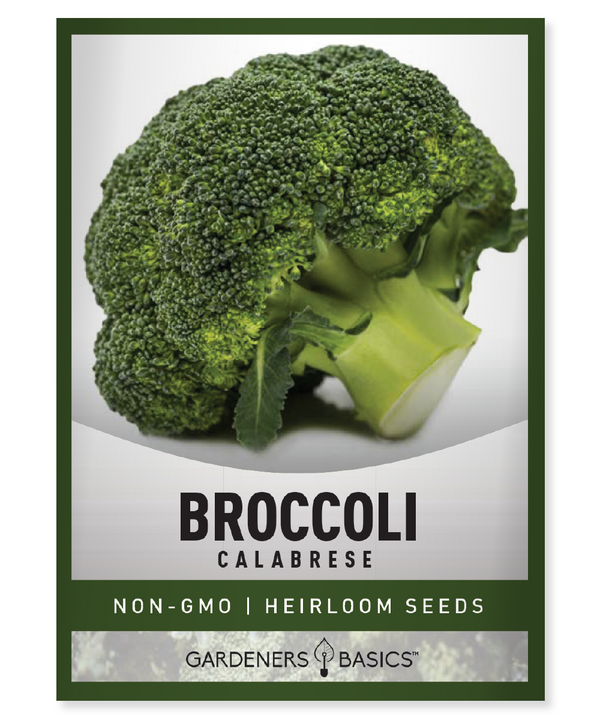
$2.49
Calabrese Broccoli Seeds – Heirloom, Non-GMO, Non-Hybrid, Open-Pollinated Grow your own delicious and nutrient-packed Calabrese Broccoli with our premium heirloom seeds! Known for its tender florets and exceptional flavor, Calabrese Broccoli is a classic Italian variety perfect for home… read more
To prevent damping off, a fungal disease that can affect young seedlings, make sure to use clean, sterilized containers and soil. Water your seedlings from the bottom to avoid getting the foliage wet, and provide good air circulation around your plants.
Broccoli plants can also benefit from regular fertilization. Use a balanced, organic fertilizer every four to six weeks to provide your plants with the nutrients they need to thrive.
Broccoli plants typically take 70 to 100 days from seed to harvest, depending on the variety. You'll know your broccoli is ready to harvest when the heads are tight and compact. Use a sharp knife or scissors to cut the head off the plant, leaving a few inches of stem attached. Your plant may continue to produce side shoots after the main head is harvested, so keep an eye out for those as well.
Growing broccoli from seed is a fun and rewarding experience that can yield a delicious and nutritious harvest. With the right soil, light, and care, you can grow healthy, productive broccoli plants in your garden. Remember to choose a variety suited to your climate, provide consistent moisture and fertilization, and watch out for pests and diseases.
Starting Broccoli Seeds Indoors
Starting broccoli seeds indoors is a great way to get a head start on your growing season and ensure healthy, robust plants. By starting your broccoli seeds indoors, you can control the growing conditions and give your plants a better chance of success. Let's learn how to grow broccoli from seed indoors.
The first step to starting broccoli seeds indoors is to gather your supplies. You'll need seed-starting trays or pots, seed-starting soil, broccoli seeds, and a sunny location. You may also want to use a heating mat to help promote germination.
Fill your seed-starting trays or pots with seed-starting soil, leaving about ¼ inch of space at the top. Gently water your soil, being careful not to displace the seeds once you plant them.
To plant your broccoli seeds, make a small hole in the soil with your finger or a pencil, about ¼ inch deep. Drop one or two seeds into the hole, and cover them with soil. Space your seeds about 2 inches apart.
Broccoli seeds need consistent moisture to germinate, so keep the soil moist but not waterlogged. You can mist your seeds with a spray bottle or use a gentle watering can to avoid dislodging the seeds.
To promote germination, cover your seed-starting trays with plastic wrap or a humidity dome. This will help keep the soil moist and warm, creating a mini greenhouse effect. Once your seeds have sprouted, remove the plastic wrap or humidity dome and move your seedlings to a sunny location.
Broccoli seedlings need at least six hours of direct sunlight each day, so place them near a south-facing window or under grow lights. If you're using grow lights, keep them about 2 inches above the seedlings and adjust the height as the plants grow.
As your broccoli seedlings grow, they may need to be thinned out to prevent overcrowding. Choose the strongest seedling in each cell or pot and snip the others off at the soil line. This will give your remaining seedlings more room to grow and access to more nutrients.
After your seedlings have grown to a height of 3 to 4 inches, they are ready to be transplanted into your garden. Before transplanting, harden off your seedlings by gradually exposing them to outdoor conditions. Start by placing them outside for a few hours each day in a sheltered, shady spot. Gradually increase the amount of time they spend outside and the amount of sun they are exposed to over the course of a week or two.
To transplant your broccoli seedlings, choose a location in your garden that receives full sun and has well-draining soil. Dig a hole that is slightly larger than the root ball of your seedling, and gently remove the seedling from its pot. Place the seedling in the hole, backfill with soil, and water thoroughly.
Broccoli plants need consistent moisture to produce large, healthy heads. Water your plants deeply once or twice a week, depending on the weather. Mulch around your plants to help retain moisture and suppress weeds.
As your broccoli plants grow, they may attract pests such as aphids, cabbage loopers, or flea beetles. Keep an eye out for any signs of pest damage and take action promptly. You can use organic methods such as hand-picking or insecticidal soap to control pests.
Broccoli plants can also benefit from regular fertilization. Use a balanced, organic fertilizer every four to six weeks to provide your plants with the nutrients they need to thrive.
Broccoli plants typically take 70 to 100 days from seed to harvest, depending on the variety. You'll know your broccoli is ready to harvest when the heads are tight and compact. Use a sharp knife or scissors to cut the head off the plant, leaving a few inches of stem attached. Your plant may continue to produce side shoots after the main head is harvested, so keep an eye out for those as well.
Starting broccoli seeds indoors is a great way to get a head start on your growing season and ensure healthy, robust plants. With the right soil, light, and care, you can grow healthy, productive broccoli plants in your garden. Remember to keep the soil moist but not waterlogged, provide consistent light and warmth, and harden off your seedlings before transplanting them outside.
Seed Safe Survival Seed Kit - 35 Variety Pack
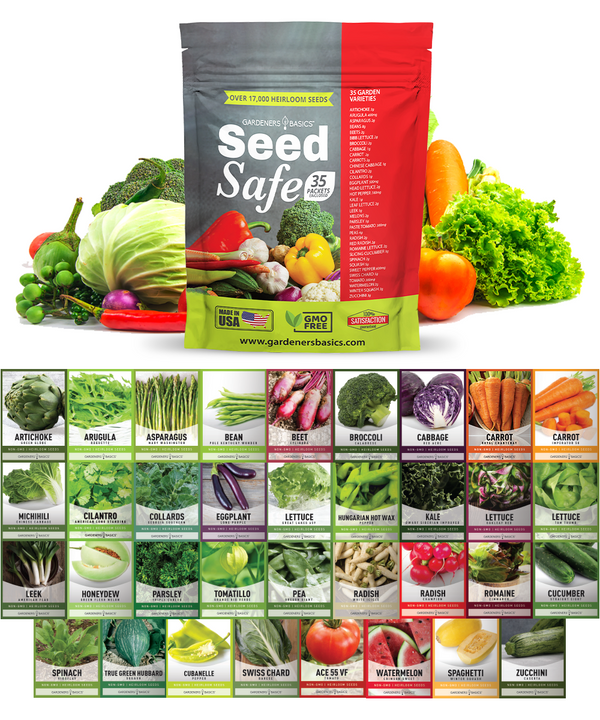
$29.95
$49.95
Seed Safe Survival Seed Kit: The Ultimate Heirloom Collection for Self-Sufficient Gardening Introducing the Seed Safe - 35 Varieties of Heirloom Vegetable, Herb, and Fruit Seeds, the ultimate solution for gardeners who want to secure a bountiful future harvest. This… read more
Broccoli Seed Soil
Choosing the right soil for your broccoli seeds is essential for healthy plant growth and a bountiful harvest. Broccoli plants require well-draining soil that is rich in organic matter and nutrients.We'll walk you through everything you need to know to choose the right soil for your broccoli seeds.
The first step to choosing the right soil for your broccoli seeds is to test your soil's pH. Broccoli plants prefer a slightly acidic soil pH of around 6.0 to 7.0. You can test your soil pH using a soil testing kit from your local nursery or online.
If your soil pH is too low, you can raise it by adding lime to your soil. If your soil pH is too high, you can lower it by adding sulfur to your soil. Follow the instructions on the package carefully and retest your soil pH after adding amendments.
Once you've adjusted your soil pH, it's time to prepare your soil for planting. Broccoli plants prefer well-draining soil that is rich in organic matter. Before planting, amend your soil with compost or aged manure. This will help improve soil structure, fertility, and water retention.
When planting your broccoli seeds, make sure to plant them in loose, crumbly soil that is free of rocks and debris. Broccoli seeds should be planted ¼ to ½ inch deep and spaced about 2 inches apart.
Broccoli seeds need consistent moisture to germinate, so keep the soil moist but not waterlogged. You can mist your seeds with a spray bottle or use a gentle watering can to avoid dislodging the seeds. Once your seeds have sprouted, you can reduce the frequency of watering but be sure to keep the soil consistently moist.
As your broccoli seedlings grow, they will require more nutrients to support their growth. Broccoli plants are heavy feeders and require soil rich in nitrogen, phosphorus, and potassium. To provide your plants with the nutrients they need, you can fertilize your soil with a balanced, organic fertilizer.
When fertilizing your soil, be sure to follow the instructions on the package carefully. Over-fertilizing can lead to nutrient burn and other problems. Apply fertilizer every four to six weeks during the growing season, and water your plants thoroughly after fertilizing.
In addition to fertilizing your soil, you can also use organic amendments such as bone meal or fish emulsion to improve soil fertility. These amendments can be added to your soil before planting or top-dressed around your plants during the growing season.
To maintain healthy soil, it's important to practice good soil management techniques. This includes avoiding compaction, minimizing soil disturbance, and rotating your crops. Broccoli plants should not be planted in the same location for more than two years in a row to prevent soil-borne diseases and pests from building up in the soil.
Choosing the right soil for your broccoli seeds is essential for healthy plant growth and a bountiful harvest. Be sure to test your soil's pH, amend your soil with compost or aged manure, and fertilize your soil with a balanced, organic fertilizer. Practice good soil management techniques to maintain healthy soil and prevent soil-borne diseases and pests.
Watering Broccoli Seeds
Watering your broccoli seeds properly is essential for successful germination and healthy plant growth. Broccoli seeds require consistent moisture to germinate, but overwatering can lead to problems such as damping off and root rot. Learning how to properly water broccoli as you learn how to grow broccoli from seed is so important.
The first step to watering your broccoli seeds properly is to choose the right container or pot. Seed-starting trays or pots with drainage holes are ideal, as they allow excess water to drain away from the soil. This helps prevent overwatering and allows oxygen to reach the roots.
When watering your broccoli seeds, use room-temperature water that has been allowed to sit for at least 24 hours. This will help remove any chlorine or other chemicals that may be harmful to your seeds.
To water your seeds, pour water into the bottom of your container or pot and let it soak up into the soil. This will help ensure that the water reaches the roots of your seeds without disturbing them.
Broccoli seeds need consistent moisture to germinate, so check your soil regularly and water as needed. The soil should be moist but not waterlogged. You can use a soil moisture meter or simply stick your finger into the soil to check for moisture.
If your soil is too dry, water it immediately. If your soil is too wet, allow it to dry out slightly before watering again. Overwatering can lead to problems such as damping off, a fungal disease that affects young seedlings.
As your broccoli seeds germinate and grow, you can reduce the frequency of watering but be sure to keep the soil consistently moist. You can mist your seedlings with a spray bottle or use a gentle watering can to avoid dislodging the seeds or damaging the delicate foliage.
To avoid overwatering, make sure to provide good drainage for your plants. If your soil is heavy or tends to retain moisture, consider adding perlite or vermiculite to improve drainage. You can also raise your seedlings off the bottom of the container or pot using a seedling tray or a layer of rocks. This will allow excess water to drain away from the soil.
In addition to providing consistent moisture, it's important to avoid letting your soil dry out completely. Dry soil can cause stress to your plants and lead to poor growth and development. To prevent your soil from drying out, you can add a layer of mulch around your plants. This will help retain moisture and also suppress weeds.
When watering your broccoli plants in the garden, use a soaker hose or drip irrigation system to provide deep, consistent watering. Avoid overhead watering, as this can lead to fungal diseases and other problems. Water your plants deeply once or twice a week, depending on the weather and soil conditions.
It's also important to water your plants at the right time of day. Watering in the morning or early evening is ideal, as this allows the water to soak into the soil before the heat of the day evaporates it. Avoid watering in the middle of the day, as this can cause the water to evaporate too quickly and also increase the risk of sunburn on your plants.
As your broccoli plants grow, they may require more water to support their growth. Keep an eye on the soil moisture and adjust your watering schedule as needed. Remember, it's better to underwater than overwater your plants, as overwatering can lead to root rot and other problems.
Watering your broccoli seeds properly is essential for successful germination and healthy plant growth. Choose a container or pot with good drainage, use room temperature water that has been allowed to sit for at least 24 hours, and provide consistent moisture without overwatering. Use a soaker hose or drip irrigation system to water your plants in the garden, and water at the right time of day to prevent evaporation and sunburn.
Vegetable Seed Vault Kit | 35 Variety Pack
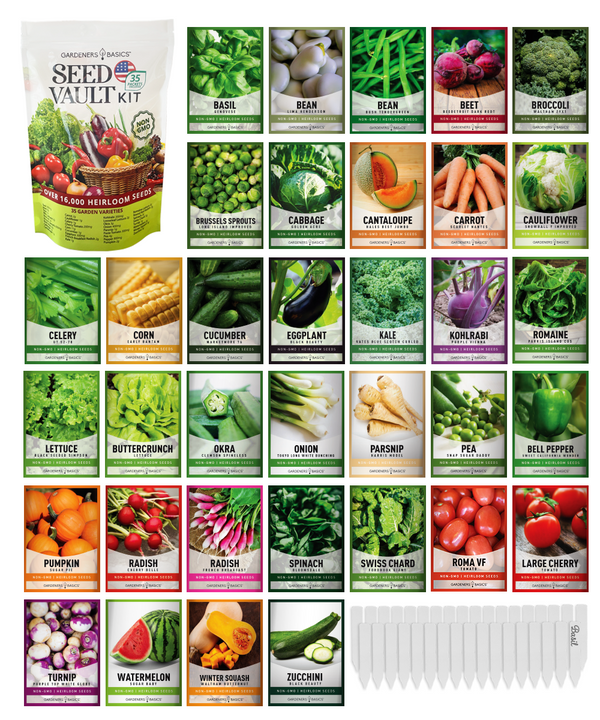
$29.95
$49.95
Ultimate Survival Seed Vault: 16,000+ Non-GMO Heirloom Vegetable Seeds for Emergency Preparedness Introducing the Seed Vault Kit, your all-in-one solution for emergency preparedness and sustainable gardening. This premium seed kit contains over 16,000 non-GMO, Heirloom, Non-Hybrid, and Open Pollinated seeds,… read more
Transplanting Broccoli Seedlings
Transplanting broccoli seedlings from indoors to outdoors is an important step in the growing process that can help ensure healthy, productive plants. Broccoli seedlings need to be properly acclimated to outdoor conditions before being transplanted to prevent shock and stress.
The first step to transplanting your broccoli seedlings is to choose the right time. Broccoli seedlings should be transplanted outside when they are 3 to 4 inches tall and have at least two sets of true leaves. This usually takes 4 to 6 weeks after germination.
Before transplanting, it's important to harden off your seedlings by gradually exposing them to outdoor conditions. Start by placing your seedlings outside for a few hours each day in a sheltered, shady spot. Gradually increase the amount of time they spend outside and the amount of sun they are exposed to over the course of a week or two.
To transplant your broccoli seedlings, choose a location in your garden that receives full sun and has well-draining soil. Dig a hole that is slightly larger than the root ball of your seedling, and gently remove the seedling from its pot. Place the seedling in the hole, backfill it with soil, and water thoroughly.
To prevent transplant shock, it's important to keep your newly transplanted seedlings moist and protected from the sun and wind for the first few days. You can use a shade cloth or a row cover to provide some shade and protection. Water your plants deeply once or twice a week, depending on the weather and soil conditions.
As your broccoli plants grow, they will require more space and nutrients to support their growth. Broccoli plants should be spaced about 18 to 24 inches apart to allow for adequate air circulation and prevent overcrowding. Overcrowding can lead to poor growth and development and increase the risk of pests and diseases.
Broccoli plants prefer well-draining soil that is rich in organic matter and nutrients. To improve soil fertility, you can add compost, aged manure, or other organic amendments to your soil before transplanting.
When transplanting your seedlings, be sure to plant them at the same depth as they were in their pots. Avoid burying the stems too deeply, as this can lead to stem rot and other problems.
After transplanting, keep an eye out for any signs of stress or disease in your seedlings. If you notice any yellowing or wilting leaves, or if your plants appear to be struggling, take action promptly. You can use organic methods such as hand-picking or insecticidal soap to control pests and diseases.
As your broccoli plants mature, they will begin to form heads. To encourage the growth of larger, more robust heads, you can use a technique called side-dressing. Side-dressing involves applying fertilizer or compost around the base of your plants. This will provide your plants with the nutrients they need to produce healthy, productive heads.
In addition to side-dressing, it's important to provide consistent moisture and weed control for your plants. Mulch around your plants to help retain moisture and suppress weeds. Water your plants deeply once or twice a week, depending on the weather and soil conditions.
Harvesting your broccoli plants is a rewarding experience that requires a bit of patience and timing. Broccoli heads should be harvested when they are tight and compact, usually when the buds are about the size of a match head. Use a sharp knife or scissors to cut the head off the plant, leaving a few inches of stem attached. Your plant may continue to produce side shoots after the main head is harvested, so keep an eye out for those as well.
Transplanting broccoli seedlings from indoors to outdoors is an important step in the growing process that requires careful planning and attention to detail. Harden off your seedlings before transplanting, choose a location with well-draining soil and full sun, and provide consistent moisture and protection from the sun and wind. Use organic methods to control pests and diseases, side-dress your plants to encourage healthy growth, and harvest your broccoli heads when they are tight and compact.
Fertilizing Broccoli Plants
Fertilizing your broccoli plants is essential for healthy, productive growth and a bountiful harvest. Broccoli plants are heavy feeders and require soil that is rich in nitrogen, phosphorus, and potassium. As you know how to grow broccoli from seed the next step is learning how to fertilize your plants so they grow big and strong.
The first step to fertilizing your broccoli plants is to test your soil's nutrient levels. A soil test will give you a baseline for the nutrient levels in your soil and help you determine which fertilizers to use.
Broccoli plants require soil that is high in nitrogen, which is essential for plant growth and the development of healthy leaves and stems. A balanced fertilizer with a higher nitrogen content, such as a 10-10-10 or 20-20-20 blend, can provide the nutrients your plants need.
When fertilizing your broccoli plants, be sure to follow the instructions on the package carefully. Over-fertilizing can lead to nutrient burn and other problems. Apply fertilizer every four to six weeks during the growing season, and water your plants thoroughly after fertilizing.
In addition to using a balanced fertilizer, you can also use organic amendments such as compost, aged manure, or bone meal to improve soil fertility. These amendments can be added to your soil before planting or top-dressed around your plants during the growing season.
To ensure that your plants are getting the right amount of nutrients, it's important to monitor their growth and adjust your fertilization schedule as needed. If your plants are growing slowly or appear stunted, they may need more nutrients. If your plants are growing too quickly or appear to be stressed, they may be getting too much fertilizer.
It's also important to provide your plants with the right type of fertilizer at the right time. In the early stages of growth, your broccoli plants will require more nitrogen to support leaf and stem growth. As your plants mature and begin to form heads, they will require more phosphorus and potassium to support flower and fruit development.
To provide your plants with the nutrients they need at the right time, you can use a technique called side-dressing. Side-dressing involves applying fertilizer or compost around the base of your plants. This will provide your plants with the nutrients they need to produce healthy, productive heads.
When side-dressing your plants, be sure to apply the fertilizer or compost evenly around the base of each plant. Avoid getting fertilizer or compost on the leaves or stems of your plants, as this can cause damage or burning.
In addition to fertilizing your plants, it's important to practice good soil management techniques to maintain healthy soil. This includes avoiding compaction, minimizing soil disturbance, and rotating your crops. Broccoli plants should not be planted in the same location for more than two years in a row to prevent soil-borne diseases and pests from building up in the soil.
Fertilizing your broccoli plants properly is essential for healthy, productive growth and a bountiful harvest. Test your soil's nutrient levels, use a balanced fertilizer with higher nitrogen content, and apply fertilizer every four to six weeks during the growing season. Use organic amendments such as compost or aged manure to improve soil fertility, and side-dress your plants to provide the right nutrients at the right time. Practice good soil management techniques to maintain healthy soil and prevent soil-borne diseases and pests.
Pests on Broccoli Plants
Pests are a common problem for broccoli plants and can cause damage to leaves, stems, and heads. Identifying and controlling pests on your broccoli plants is essential for healthy, productive growth and a bountiful harvest.
The first step to controlling pests on your broccoli plants is to identify the type of pest you are dealing with. Common pests on broccoli plants include aphids, cabbage worms, and flea beetles.
Aphids are small, soft-bodied insects that suck sap from the leaves and stems of your plants. They can cause stunted growth, wilting, and yellowing of leaves. To control aphids, you can use a strong stream of water to wash them off your plants or use an insecticidal soap or neem oil spray.
Cabbage worms are green caterpillars that feed on the leaves of your plants. They can cause large holes in the leaves and reduce plant growth and yield. To control cabbage worms, you can hand-pick them off your plants or use a natural pesticide such as Bacillus thuringiensis (Bt).
Flea beetles are small, black insects that jump when disturbed. They can cause small holes in the leaves of your plants and reduce growth and yield. To control flea beetles, you can use a row cover to protect your plants or use a natural pesticide such as pyrethrin.
In addition to these common pests, broccoli plants can also be susceptible to other pests such as cutworms, slugs, and snails. Cutworms are caterpillars that feed on the stems of your plants, causing them to wilt and die. To control cutworms, you can use a collar made of cardboard or plastic around the base of your plants to prevent them from climbing up the stem.
Slugs and snails can also be a problem for broccoli plants, especially in wet conditions. They can cause holes in the leaves and feed on the developing heads. To control slugs and snails, you can use a bait trap or hand-pick them off your plants.
Preventing pests on your broccoli plants is key to controlling infestations. You can prevent pests by using good cultural practices such as crop rotation, maintaining good soil health, and providing adequate air circulation. Avoid overcrowding your plants and keep them well-watered and fertilized to reduce stress and promote healthy growth.
Using natural predators such as ladybugs and lacewings can also help control pest populations on your plants. These beneficial insects feed on aphids and other pests and can help keep their populations under control.
If you do need to use a pesticide to control pests on your broccoli plants, be sure to use it safely and according to the instructions on the label. Avoid using pesticides that are harmful to beneficial insects and follow the recommended application rates and timing.
Identifying and controlling pests on your broccoli plants is essential for healthy, productive growth and a bountiful harvest. Identify the type of pest you are dealing with and use natural methods such as hand-picking or using natural predators to control infestations. Use good cultural practices to prevent pests from taking hold, and use pesticides safely and according to the label instructions when necessary.
Companion Planting with Broccoli
Companion planting is a gardening technique that involves planting different crops together to benefit each other. Companion planting with broccoli can help improve soil health, control pests, and increase yields. Now you know how to grow broccoli from seed, what should you companion plant with it? Let's explore.
The first step to companion planting with broccoli is to choose the right companion plants. Good companion plants for broccoli include herbs such as chamomile, dill, and thyme, as well as other vegetables such as lettuce, spinach, and beets. These plants can help improve soil health, control pests, and increase yields.
Chamomile is a good companion plant for broccoli because it attracts beneficial insects such as ladybugs and lacewings that feed on aphids and other pests. Dill is also a good companion plant for broccoli because it attracts beneficial insects and can help repel pests such as cabbage worms.
Lettuce and spinach are good companion plants for broccoli because they have shallow roots and can help suppress weeds. Beets are also a good companion plant for broccoli because they have deep roots that can help break up compacted soil and improve soil health.
In addition to choosing the right companion plants, it's important to plant your companion plants at the right time and in the right location. Plant your companion plants at the same time as your broccoli plants and choose a location that receives full sun and has well-draining soil.
Spacing is also important when companion planting with broccoli. Be sure to give your companion plants enough space to grow and avoid overcrowding your plants. Overcrowding can lead to poor growth and development and increase the risk of pests and diseases.
Companion planting with broccoli can also help improve soil health by adding nutrients and organic matter to the soil. Legumes such as peas, beans, and clover can fix nitrogen in the soil, which is essential for plant growth and development. Planting legumes with broccoli can help improve soil fertility and reduce the need for fertilizers.
Another benefit of companion planting with broccoli is pest control. Certain companion plants can help repel or deter pests that may attack your broccoli plants. For example, marigolds are a good companion plant for broccoli because they release chemicals that repel pests such as nematodes and aphids.
On the other hand, some companion plants can attract pests to your garden. For example, planting tomatoes or peppers near broccoli can attract pests such as flea beetles and aphids. Be sure to research the potential benefits and drawbacks of companion planting with different crops before planting them together.
Companion planting with broccoli can also help improve biodiversity in your garden, which can lead to a healthier ecosystem and increased resilience against pests and diseases. By planting a variety of crops together, you can create a balanced ecosystem that supports a wide range of beneficial insects and microorganisms.
Companion planting with broccoli is a great way to improve soil health, control pests, and increase yields. Choose the right companion plants, plant them at the right time and in the right location, and give them enough space to grow. Be sure to research the potential benefits and drawbacks of different companion plants before planting them together.
How to Harvest Broccoli
Harvesting your broccoli plants properly is essential for enjoying a bountiful and delicious harvest. Broccoli plants produce large heads that are ready to be harvested when they are firm, compact, and dark green or purple in color. In this article, we'll walk you through everything you need to know to harvest your broccoli plants properly.
The first step to harvesting your broccoli plants is to know when to harvest. Broccoli heads are ready to be harvested when they are fully formed and before the buds begin to open into flowers. This is typically 55-100 days after planting, depending on the variety and growing conditions.
To harvest your broccoli plants, use a sharp knife or pruning shears to cut the main stem of the plant just below the head. Be sure to leave at least 6 inches of stem attached to the head to allow for regrowth and potential side shoots.
When harvesting your broccoli plants, be sure to handle the heads carefully to avoid bruising or damaging them. Place the heads in a basket or container and keep them out of direct sunlight and heat.
If you notice that your broccoli heads are beginning to flower, this is a sign that they have been left on the plant too long and are no longer suitable for harvesting. Flowering heads are tough, bitter, and less flavorful than fully formed heads.
In addition to harvesting the main head of your broccoli plant, you can also harvest side shoots for continued production. Side shoots are smaller heads that grow on the plant after the main head has been harvested. To encourage side shoot production, cut the main stem just above a leaf node after harvesting the main head.
It's important to note that harvesting your broccoli plants at the right time is essential for flavor and nutrition. Fully formed heads are rich in vitamin C, vitamin K, and other essential nutrients. Overripe or underripe heads can be tough, bitter, and less nutritious.
In summary, harvesting your broccoli plants properly is essential for enjoying a bountiful and delicious harvest. Harvest your broccoli heads when they are fully formed and before the buds begin to open into flowers. Use a sharp knife or pruning shears to cut the main stem just below the head and handle the heads carefully to avoid bruising or damaging them. Harvest side shoots for continued production, and be sure to harvest your heads at the right time for optimal flavor and nutrition.
Please stop by our store for all your broccoli seeds for your home garden!
Waltham 29 Broccoli Seeds
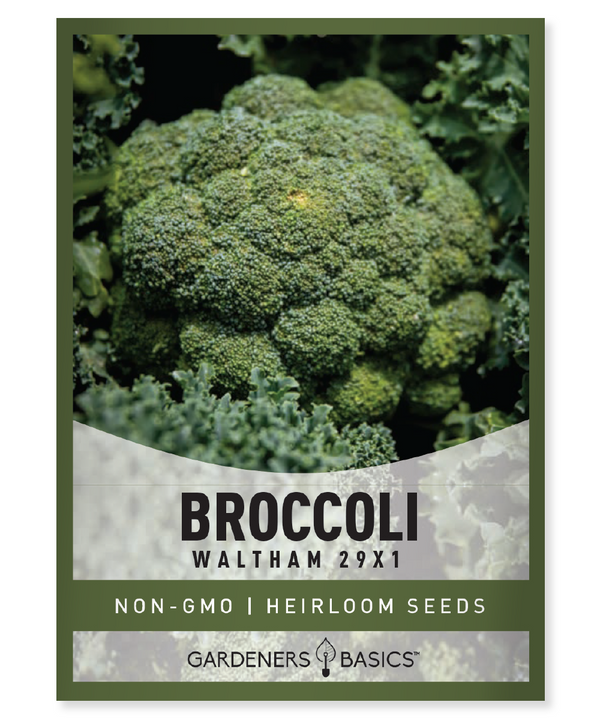
$2.49
Waltham Broccoli Seeds – Heirloom, Non-GMO, Non-Hybrid, Open-Pollinated Grow the perfect garden with our premium Waltham 29x1 Broccoli seeds, a versatile, cold-tolerant heirloom variety that produces large, flavorful heads with tender side shoots for extended harvests. These seeds are non-GMO,… read more
Frequently Asked Questions (FAQs)
Q: How many hours of sunlight do broccoli seeds need?
A: Broccoli seeds require at least 6 hours of sunlight per day to grow well. In areas with hot summers, it's best to provide partial shade during the hottest part of the day to prevent heat stress.
Q: How often should I fertilize my broccoli plants?
A: Broccoli plants benefit from regular fertilization throughout the growing season. Use a balanced fertilizer with equal amounts of nitrogen, phosphorus, and potassium, applying it every 2-3 weeks.
Q: Can I grow broccoli from seeds saved from a previous crop?
A: Yes, you can save seeds from your own broccoli plants to use in future crops. However, keep in mind that broccoli is a biennial plant, meaning it takes two years to complete its life cycle. So you'll need to let the plant go to seed and harvest the seeds in the second year.
Q: How can I prevent my broccoli plants from bolting?
A: Broccoli plants are prone to bolting (going to seed prematurely) when they experience stress, such as drought, high temperatures, or damage to the roots or leaves. To prevent bolting, keep the soil moist, provide partial shade during hot weather, and avoid damaging the plants.
Q: Can I grow broccoli in containers?
A: Yes, broccoli can be grown in containers as long as the container is at least 8 inches deep and 12 inches wide. Use a good-quality potting mix and make sure the container has drainage holes to prevent waterlogging.





